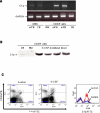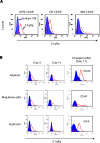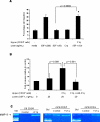Complement C1q enhances homing-related responses of hematopoietic stem/progenitor cells
- PMID: 20456695
- PMCID: PMC2974804
- DOI: 10.1111/j.1537-2995.2010.02664.x
Complement C1q enhances homing-related responses of hematopoietic stem/progenitor cells
Abstract
Background: Previously, we reported that the complement cleavage fragments C3a and C5a are important modulators of trafficking of hematopoietic stem/progenitor cells (HSPCs). The aim of this study was to examine a possible role for complement component 1, subcomponent q (C1q) in HSPC migration.
Study design and methods: CD34+ HSPCs isolated from cord blood (CB), bone marrow (BM), and granulocyte-colony-stimulating factor (G-CSF)-mobilized peripheral blood (mPB) were evaluated for the expression of C1q and its receptor for phagocytosis (C1qRp) using reverse transcription-polymerase chain reaction, Western blotting, and fluorescence-activated cell sorting. Chemotactic responses and chemoinvasiveness toward stromal cell-derived factor (SDF)-1 and expression of matrix metalloproteinase (MMP)-9 were also examined after C1q stimulation. Moreover, G-CSF- and zymosan-induced mobilization was evaluated in C1q-deficient mice.
Results: C1q was expressed in CD34+ cells from mPB, but not from CB or steady-state BM; however, stimulation of the latter with G-CSF induced C1q expression. C1qRp receptor was found on BM, CB, and mPB CD34+ cells and more mature ex vivo expanded myeloid and megakaryocytic precursors. Although C1q itself was not a chemoattractant for HSPCs, it primed/enhanced the chemotactic response of CD34+ cells to a low SDF-1 gradient and their chemoinvasion across the reconstituted basement membrane Matrigel and increased secretion of MMP-9 by these cells. Moreover, in in vivo studies C1q-deficient mice were found to be easy G-CSF mobilizers compared to wild-type mice and normal zymosan mobilizers.
Conclusion: We demonstrated that C1q primes the responses of CD34+ HSPCs to an SDF-1 gradient, which may enhance their ability to stay within BM niches, suggesting that the C1q/C1qRp axis contributes to HSPC homing/retention in BM.
© 2010 American Association of Blood Banks.
Figures




References
-
- Gasque P. Complement: a unique innate immune sensor for danger signals. Mol Immunol. 2004;41:1089–98. - PubMed
-
- Lu J, Wu X. The BK. The regulatory roles of C1q. Immunobiol. 2007;212:245–52. - PubMed
-
- Sjoberg AP, Trouw LA, Blom AM. Complement activation and inhibition: a delicate balance. Trends Immunol. 2009;30:83–90. - PubMed
-
- Kishore U, Reid KBM. C1q: structure, function, and receptors. Immunopharmacol. 2000;49:159–70. - PubMed
Publication types
MeSH terms
Substances
Grants and funding
LinkOut - more resources
Full Text Sources
Medical
Miscellaneous

